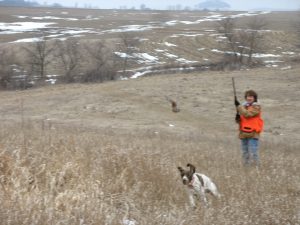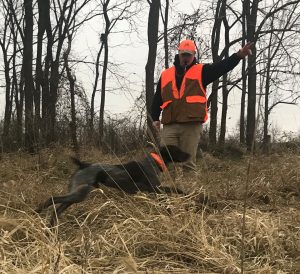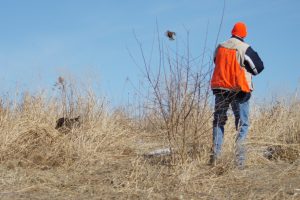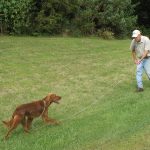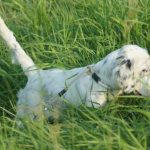POINTING DOG POINTERS: Problems in Developing the Started Dog – Gun Nervous / Gun Shy
By Bob and Jody Iler
Training your pup to be ready for his first season in the field can be a daunting task! When we say “started dog,” we mean exactly that! Though you’ve spent several months (or more) working on bird introduction, field handling, gun development, and yard work, pup’s training is an ongoing process. You’ve only scratched the surface! Even if you have a mature dog that is steady to wing and shot and polished to “perfection” – you still need to keep him that way. So – your training is never really finished!
In the past few months, you may have come up against a problem or two that you’re not sure how to fix, especially if this is the first pup you’ve developed. In our experience as trainers, one of the most common issues that a novice encounters is problems with gun development.
How do you know whether your pup is gun shy or “just” gun nervous?
If pup is gun nervous, he may flinch or stop momentarily at the shot, as if to say, “What’s that noise all about?” He may continue hunting, but with less enthusiasm. If you’ve been watching your pup for his responses as you developed him to the gun, you may have noticed these responses early on. If so, good for you! A key element of training is observing and “reading” your pup’s reactions as you progress. The gun nervous pup can generally be brought around with time and patience.
On the other hand, the gun-shy pup can be a serious problem. When he hears the shot, he will likely quit hunting entirely. He may even run back to your vehicle and try to hide. He will want no part of going back out in the field. We’ve had some gun-shy dogs here that quaked with fear at just the sight of a gun.
Both problems are generally caused by something specific that a trainer/owner has done, often what we call “man-made” faults. For example, we create gun issues by pushing a pup too fast to get him to the shotgun stage, by not spending enough time on bird work and fun in the field, by firing too many shots over the pup, and by not reading the clues evident in our pup’s responses to noise and gunfire as training progresses. And from the get-go, the development program should be geared to pup’s temperament. Easy does it for the soft, timid types – bolder pups may progress more easily.
But in any and all cases remember this:
The pup that is bird crazy has the best chance of being cured of gun shyness.
Below are some guidelines to help you with both the gun nervous or the gun-shy pup.
Back to the Basics
Now is the time to go back to the basics with your pup, just as though he is a newbie starting out. Everything should be fun, positive and pressure-free. No goals to meet, no timetable to follow, no restraints on point, no heavy hand of obedience or yard work. Instead, you want to demonstrate lots and lots of patience and sweet talk, and allow plenty of time letting pup be a pup in the field. Pretend he’s just a few months old and you’re starting out fresh.
Take Away the Gun Completely
Right now, you’ll put the guns and noisemakers such as blocks and pop guns away. There’ll be time to get them out later. Resist the impulse to “test” your dog and see if he’s still gun nervous or gun shy! If you do, we can guarantee you that he surely still is – and not resisting this urge to see will set you back.
Bird Work Only
Encourage your pup to chase birds with abandon – catching birds is allowed during this time as well! Make sure pup has access to frequent sessions with birds like quail. These little birds will develop his confidence. It won’t hurt right now to have some poor flyers that go up and then come down – this will encourage your pup to chase and grab the bird. Pigeons will work too, but they will tend to readily fly up and away. Be watchful of working your pup at a game preserve or hunt club grounds. There could be other hunters or owners out there using guns – this too, would set you back in what you’re trying to accomplish.
Work Pup Alone
It’s best to work your pup alone, with no other dogs or owners to distract or hinder your pup. Focus on bird work and developing pup’s confidence. However, if you have a friend with a pup that is bird crazy, it can sometimes instill extra excitement in your pup to watch the other pup run and hunt, while he awaits his turn (restrained on a lead). It should go without saying that no guns or noise would be used at this time!
GRADUALLY Reintroduce Noise
If all is going well and your pup is hunting, chasing, and even catching birds with zest and enthusiasm, it’s time to start reintroducing noise – very, very gradually. First, go back and re-read our column on proper gun development and gun progression. Then begin by clapping blocks together gently as pup chases a flushed bird. Watch for his reaction! If he doesn’t pay any attention, great! Continue on with the progression slowly, over several sessions or more for each level. Always watch your pup’s response. If you see that pup is noticing the noise, it’s time to step back a level or more. Stay at that comfort level for as long as necessary. The more time you spend now, the better your chances are of repairing any damage that’s been done – and your pup is worth it.
Keep Your Lessons Short – End on Positive Note
As you develop your pup all over again to the gun, remember to keep your lessons short and always, always end on a positive note. Resist the urge to try “just one more shot.” One short, successful session is worth everything! Remember, we want no pressure during this rehabilitation time, only fun and positive outcomes.
Don’t Shoot a Bird that Pup is not Working
As you reach the stage where you’re able to shoot a bird over your pup again, only shoot a bird that pup has been working or chasing and that he sees as it’s flying away. We had one of our pups go gun nervous when a fellow hunter in an adjacent area shot a bird over his dog and our pup heard the shot but didn’t associate it with a bird. She quit hunting and returned to our side.
No More than Two Shots at a Time
It’s always important not to expose your young started dog to excessive gunfire. If a bird can’t be hit in one or two shots, let it go. It’s especially important with a newly “recovered” pup that is getting back in the groove to limit your gunshots. It’s also a good idea to hunt alone for awhile or with just one buddy, and then determine who will get the shot each time.
About Fireworks
This year, with the lack of annual fireworks celebrations in our area on the 4th of July, a special problem with dogs and fireworks developed. People bought fireworks and set them off at home, sometimes evening after evening and sometimes in competition with neighbors. And yes, our dogs pay the price. We have one friend whose dog we helped develop last year. This young dog is especially terrified of fireworks. For at least several weeks she was on regular doses of tranquilizers, even with being sequestered in an inside room with white noise. We are hoping she’ll be OK at the game preserve this fall.
Over the years, we’ve had many dogs at our kennel that were gun nervous or gun-shy. Some we were able to “fix” – and some we weren’t. What we can say with certainty is that if you go very slow in your gun development training and watch your pup’s responses, adjusting accordingly – your chances are very good – as long as your pup is bird crazy. With the eye of the tiger, your pup will get past the gunshyness. Good luck!
Pointing Dog Pointers features monthly training tips by Bob and Jody Iler, who own Green Valley Kennels in Dubuque, Iowa. Bob and Jody have trained pointing dogs for over 35 years and have written many articles for Pointing Dog Journal.



